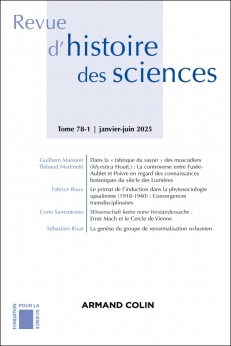
REVUE D'HISTOIRE DES SCIENCES (1/2025)
Pour acheter ce numéro, contactez-nous
Recevez les numéros de l'année en cours et accédez à l'intégralité des articles en ligne.
La phytosociologie, science qui étudie les associations d’espèces végétales, a été développée dans les années 1920 par plusieurs écoles aux méthodologies bien différentes. Les raisonnements mobilisés dans la méthode d’Upsal sont examinés en détail. La thèse défendue ici est que les outils de traitement des relevés floristiques effectués par les botanistes de cette école, au premier rang desquels Gustaf Einar Du Rietz, dérivent logiquement d’un positionnement épistémologique initial qui surdétermine les autres. Davantage que les auteurs qu’il mentionne comme références fondatrices, l’inductivisme radical de Du Rietz apparaît comme la source essentielle de l’appareil méthodologique et des représentations qu’il tente de diffuser. Cette hypothèse se trouve confortée par l’examen d’auteurs ayant eu la même prémisse méthodologique, l’induction pure, dans d’autres sciences qui opèrent sur d’autres collectifs hétérogènes afin d’en déterminer l’intelligibilité : l’anthropologie et la botanique systématique. Les représentations auxquelles on aboutit en partant du même principe initial, sont en effet proches de celles que Du Rietz a affirmé pour la végétation : description structurale d’objets en réseau, qui se prête à l’analyse statistique, peu attachée à la recherche des causes explicatives, en particulier celles invoquant le milieu.
The science of plant sociology, or the study of associations between plant species, experienced a major period of development in the 1920s, through the work of different authors identified as leaders of “methodological schools.” Here, we propose a thorough study of the school of Uppsala. We argue that the treatment of floristic data by the botanists of this methodological current, whose main representative was Gustaf Einar Du Rietz, are a logical consequence of an initial epistemic position that overdetermines the others. As far as the rep-resentations and methodologies are concerned, the inductivist choice made by Du Rietz appears to be far more important than the authors quoted by him as the source of his own system. This hypothesis seems to be corroborated by a parallel study of allied sciences, namely anthropology and botanical systematics, which also work with collections of heterogeneous objects that need to be ordered in an intelligible way. In these disciplines, authors with “pure induction” as their fundamental premiss for good scientific work, developed quite a similar pattern to the vegetation depicted by Du Rietz: a structural description of elements in a network, designed for statistical analysis, little interest in causal explanation, particularly in terms of environmental determinism.